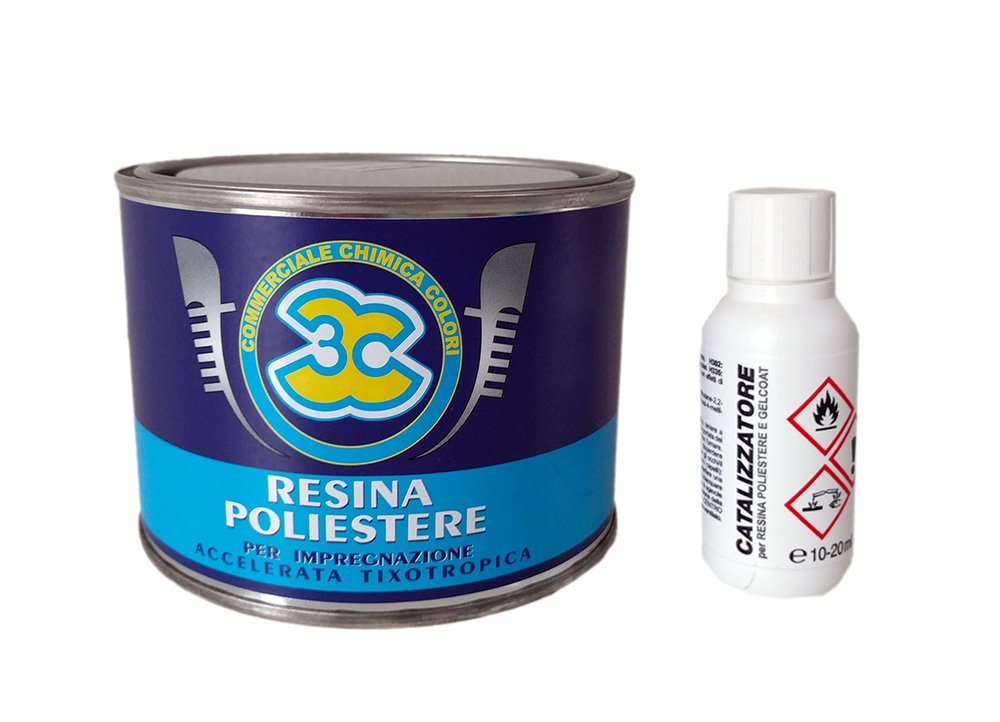
OUTLET
3C Polyester Resin A+B - 0.385 LT
Save 50%
Only 1 left
Regular price
€9,90 EUR
incl. VAT
Sale price
€9,90 EUR
incl. VAT
Regular price
€19,90 EUR
🕒 Order preparation: in 1 to 3 business days
Some products are located in external warehouses
MPN
: 01.6.3CRESINLT.375
3C Polyester Resin A+B - 0.385 LT
It is an unsaturated polyester resin orthophthalic, thixotropic and accelerated, fast curing and low exothermicity. Our polyester resin is packaged in sizes of 0.375lt., 0.750lt, 4lt. and 18 lt. The polyester resin is also provided in a repair kit for fiberglass in packs of 0,375 lt and 0,750 It. The repair kit, in addition to the resin and its hardener, is composed of a glass for mixing, 1 m2 of glass fiber (mat), 1 brush, 2 latex gloves. STABILITY AND STORAGE: The product is stable for 6 months if stored in stainless steel tanks or in lacquered drums (avoid fiberglass containers or galvanized iron), at 20 ° C away from light and heat sources away from ferrous or copper salts , organic and inorganic peroxides. It is advisable to mix the product before using it. INSTRUCTIONS FOR USE: APPLICATION: The resin is used for the construction of reinforced plastic large or for small repairs. Its reduced tendency for sagging allows easy application even on steep sloped walls. The indicator presence of catalysis, which turns from blue-green to yellow-brown, also allows you to check the king homogeneous distribution of the peroxide (eg. MEKP) used as a hardener. And lasted storage, the thixotropic agent tends to settle; before use it is thus appropriate to a good stirring to restore the homogeneity of the product. PREPARATION: Cut the necessary amount of MAT (glass fiber), pour the required amount of resin in a pan, then add the catalyst content in the flask in the proportion of 2 gr. Every 100 grams. resin; thoroughly mix the resin-catalyst mixture. From this time, the resin has 10 minutes of time to be spread. METHOD FOR USE: Degrease it with acetone or thinner nitro surface to be treated; You smear a catalyzed resin hand on the affected area; It lays the MAT (glass) fibers on the wet and soak with the brush moistened with other resin. The impregnation work must be done with great care, in part by eliminating the tiny air bubbles and leaving this first slightly rich layer of resin.
It is an unsaturated polyester resin orthophthalic, thixotropic and accelerated, fast curing and low exothermicity. Our polyester resin is packaged in sizes of 0.375lt., 0.750lt, 4lt. and 18 lt. The polyester resin is also provided in a repair kit for fiberglass in packs of 0,375 lt and 0,750 It. The repair kit, in addition to the resin and its hardener, is composed of a glass for mixing, 1 m2 of glass fiber (mat), 1 brush, 2 latex gloves. STABILITY AND STORAGE: The product is stable for 6 months if stored in stainless steel tanks or in lacquered drums (avoid fiberglass containers or galvanized iron), at 20 ° C away from light and heat sources away from ferrous or copper salts , organic and inorganic peroxides. It is advisable to mix the product before using it. INSTRUCTIONS FOR USE: APPLICATION: The resin is used for the construction of reinforced plastic large or for small repairs. Its reduced tendency for sagging allows easy application even on steep sloped walls. The indicator presence of catalysis, which turns from blue-green to yellow-brown, also allows you to check the king homogeneous distribution of the peroxide (eg. MEKP) used as a hardener. And lasted storage, the thixotropic agent tends to settle; before use it is thus appropriate to a good stirring to restore the homogeneity of the product. PREPARATION: Cut the necessary amount of MAT (glass fiber), pour the required amount of resin in a pan, then add the catalyst content in the flask in the proportion of 2 gr. Every 100 grams. resin; thoroughly mix the resin-catalyst mixture. From this time, the resin has 10 minutes of time to be spread. METHOD FOR USE: Degrease it with acetone or thinner nitro surface to be treated; You smear a catalyzed resin hand on the affected area; It lays the MAT (glass) fibers on the wet and soak with the brush moistened with other resin. The impregnation work must be done with great care, in part by eliminating the tiny air bubbles and leaving this first slightly rich layer of resin.

